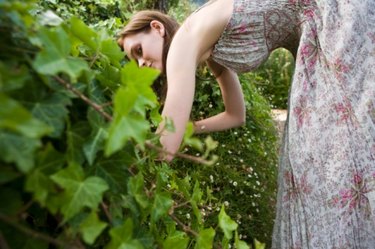
Evergreen shrubs are among the most widely used and diverse plantings in landscaping today. They provide year-round greenery, and serve as ideal privacy plantings and borders. The selection, including color, size, shape and flowering style, is vast, but varies greatly on the intended planting zone. Growers, particularly those with children or animals, should choose carefully as many evergreen shrubs may contain toxins that are lethal if ingested. There are several dozen that are not associated with this risk, and several that are partially edible.
Wax Myrtle
Video of the Day
Wax myrtle (Morella cerifera), also known as southern bayberry, is a food source for a number of wildlife species. It has been used for centuries to make candles, potpourri, oils and other scented materials. Growers should make sure to select the male plants, as the female berries may cause some mild irritation if ingested. Wax myrtle grows best in U.S. Department of Agriculture plant hardiness zones 3 through 6, and will thrive in a number of soil types and weather conditions, though it prefers sandy, wet soils and moderate sun. These plants may be found naturally in swampy areas, forests and along brackish waterways, but they are often grown as a dense shrub for privacy around homes. The plant is attractive to wildlife, particularly turkey, catbirds, thrashers and bluebirds. Once established, it requires little care.
Video of the Day
Yaupon Holly
Yaupon holly (Ilex vomitoria) is an evergreen holly commonly found in the southeastern United States. It may grow to be as tall as 30 feet, and has a natural, irregular shape. These small trees are frequently groomed into shrubs, and produce vibrant green leaves that are thick and glossy. Yaupon prefers a soil that is well drained and sandy, and it should be planted in an area with full sun or partial shade. It is naturally found in forests, coastal regions and near salty marshes, but may be grown as shrubbery in a number of growing zones. The fruit is a favorite food of birds, particularly ducks, bluebirds, sparrows and mourning doves. It may also be scavenged by deer, armadillo, bear and other critters. The leaves are edible and have been used for centuries to brew a tea.
Blueberries
Blueberries are an ideal edible plant for the home garden. Their dense foliage makes them work well as privacy plantings, and the plants are nontoxic if ingested. These plants should be provided with a slightly acidic soil that is rich in organic matter. If either of these conditions is not provided, poor growth or berry production may result. To increase acidity, add a bit of peat moss, some pine needles or sawdust, while a well decayed compost will add organic matter if needed. Good drainage and full sun or partial shade are also necessary. Certain varieties, particularly the highbush blueberry, will grow to a mature height of 5 feet.
Other Options
Homeowners looking for a nontoxic shrub have a vast selection to choose from. According to the People for the Ethical Treatment of Animals, most fruit, vegetable and herb plants are ideal. The rugosa rose (Rosa rugosa) is among the most widely used, and it is a cold-hardy variety native to China, Korea and Japan. It thrives in zones 2 through 7 and produces white or pink blossoms with edible rosehips. Rosemary (Rosemarinus officinalis) is a woody herb that originated in the Mediterranean. It is most recognized as a kitchen spice, though some varieties produce a thick mat ideal for hedges. It may require some watering and trimming once established, and it will do best in zones 7 through 10.
- University of Florida: Florida Forest Trees: Wax Myrtle
- United States Department of Agriculture: Yaupon Holly
- North Carolina State University; Growing Blueberries in the Home Garden; Charles M. Mainland, et al.; November 2002
- Ohio Department of Natural Resources: Rugosa Rose
- A Place for Animals
- PETA Prime: Yes, Fido, There Are Non-Toxic Plants!; Elizabeth Bublitz
- Pet Poison Helpline: Animal Poison Control